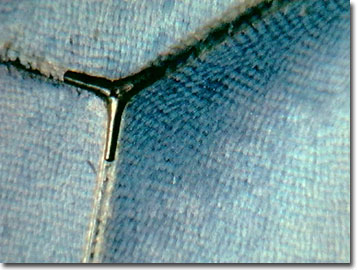Darkfield Digital Image Gallery
Morpho Butterfly Wing
As a genus of beautiful mostly iridescent blue butterflies, the species of Morpho in the family Morphidae are found in the tropical rainforests of Central and South America. The diurnal flashy butterflies are still at night, folding their brilliant blue wings up and over their bodies and revealing their cryptic under sides as they hang from branches and leaves, blending into their backgrounds.

View a high magnification image of a Morpho butterfly wing.
The scientific name for the genus is derived from the idea that there appears to be more than one type of butterfly, the brilliant blue or the cryptic brown and green body type, depending on the individual's behavior. Prized by collectors, there are many species in the genus Morpho, including a few that have tan and white wings instead of blue. Typical of tropical rainforest butterflies, adult morphos must resort to the saps and juices of leaves, fruits, and rotting dead logs to supplement their nutrition since a steady flower supply with nectar is not always available. Potential predators, other than butterfly collectors, are relatively rare and include birds, large insects, and if near water, fishes. The caterpillars are unusual in that they are often strongly cannibalistic, perhaps aiding population control, and feature hairs that irritate human skin.
Male Morpho butterflies roost together in groups at night and use a different microhabitat for feeding. During the day, much of the adult male's time and energy is expended searching for females, with the males the more colorful of the sexes. As with other species of butterfly, morphos complete egg, larval (caterpillar), pupal (chrysalis), and adult life stages. As rainforest dwellers, continual logging, clearing, burning, and expansion of agriculture and other development threatens these flying "jewels" of the jungles.
The wing structure of the Morpho butterfly has been used as a design model for multi-layered flat fibers used in clothing. It is structural color derived from optical interference of the wing scales and not pigmentation that provides the shimmering blues to Morpho butterflies. Most morphos have a wingspan of 13 to 17 centimeters (5 to 7 inches), but M. hecuba is one of the largest, with close to an 18 centimeter wingspan. Because these large lepidopterans beat their long wings slowly while in flight, their iridescent blue upper sides are only visible for short periods of time. This might make a flying predator such as a bird or insect lose track of the morpho butterfly as it periodically blends into the background browns and greens of the tropical rainforest.
Contributing Authors
Cynthia D. Kelly, Thomas J. Fellers and Michael W. Davidson - National High Magnetic Field Laboratory, 1800 East Paul Dirac Dr., The Florida State University, Tallahassee, Florida, 32310.
BACK TO THE DARKFIELD IMAGE GALLERY
BACK TO THE DIGITAL IMAGE GALLERIES
Questions or comments? Send us an email.
© 1995-2022 by Michael W. Davidson and The Florida State University. All Rights Reserved. No images, graphics, software, scripts, or applets may be reproduced or used in any manner without permission from the copyright holders. Use of this website means you agree to all of the Legal Terms and Conditions set forth by the owners.
This website is maintained by our
Graphics & Web Programming Team
in collaboration with Optical Microscopy at the
National High Magnetic Field Laboratory.
Last Modification Friday, Nov 13, 2015 at 02:19 PM
Access Count Since September 17, 2002: 14754
Visit the website of our partner in introductory microscopy education:
|
|
